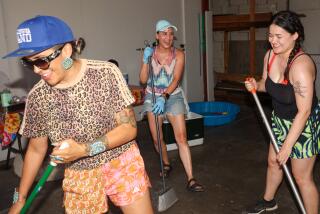A heritage with a new impetus
- Share via
No one really had any idea how many Native American writers there were in Hollywood. But when the Writers Guild of America West sent out the call for qualified writers to form their own diversity committee, only three turned out for the first meeting. Fewer than a dozen working professionals eventually signed up.
“It was shocking to find out how few of us there actually were,” said Micah Wright, the chair of the new WGAW American Indian Writers Caucus. The industry has hundreds of Native American actors but just a handful of writers, even though, as Wright said, “the American Indian culture as a whole is a storytelling culture.”
The union already had minority groups for female writers, black writers, Latino writers, Asian American writers, gay and lesbian writers, writers with disabilities and even an Age Awareness Committee for writers over 40 -- but nothing for American Indians. When Kim Myers, the WGAW’s new diversity director, was asked why last year by a member of the activist group American Indians in Film and Television, she didn’t know. So she began the process to create one.
Now, after a few meetings, the group looks forward to pursuing its mission of raising awareness of Native American writers, fostering and mentoring a new generation, and serving as a resource for other WGA members. The group claims an official membership of 11, including Wright, Jason Gavin (“Friday Night Lights”), Steven Judd (a Disney fellow working on “Mongoose and Luther”) and Travis Wright (“Eagle Eye” and no relation to Micah).
American Indians have had a tougher time than other minorities in Hollywood, Myers said. Like others, most of Hollywood’s mythmaking movies about or including American Indians were penned by writers outside their community. While blacks and Latinos particularly have made progress in selling contemporary stories about their lives to mainstream productions, Native Americans -- with the exception of the 1998 movie “Smoke Signals” -- generally have not.
One reason is that, despite the high profile of Indian casinos in some parts of the country, many Native Americans still live on isolated reservations and are physically as well as socially separated from making connections in Hollywood.
“When I was a kid, I didn’t know you can make money writing,” said Judd, who was writing spec scripts and working in a bingo hall for the Chickasaw tribe last April when he won his second fellowship from the Disney-ABC Television Group and the Walt Disney Studios. He’s living in Beverly Hills and writing on “Mongoose & Luther,” a live-action show for Disney XD, a cable channel expected to debut next year.
In his native Choctaw tribe, Judd said he grew up with a strong tradition of oral storytelling. For years, many tribes had no written language, passing down their knowledge and history largely through speech. Efforts to translate them into writing are relatively recent, Micah Wright said.
While American Indians are natural storytellers, “film isn’t a natural medium,” said Travis Wright, on a six-week artist in residence program in France working on a story about a WWI group of soldiers from Harlem. “There’s definitely a structure to the bigger kinds of movies, and that structure is knowable,” he said.
Each writer said he realizes that he must strike a delicate balance between their cultures. Each wants to include what he knows about modern American Indians but also must write universal stories to avoid being pegged as a strictly Native American writer.
“You want to be considered a mainstream artist who has the opportunity to access money, frankly, to do the movies,” Myers said. “Being pigeonholed can prevent you from having that access. On the other hand, people want to write about what they know best.”
And if more contemporary stories are told about Native Americans, the greater their chances of success, the writers said. After “Smoke Signals,” many writers thought a new era of American Indian films would blossom, but it failed to materialize. “We’re still waiting for a breakthrough,” Gavin said.
Most members said their primary interest in participating in the committee is reaching out to young writers, in native colleges, on reservations or through local tribes. The group has contacted the Institute of American Indian Arts, a Santa Fe, N.M., college that offers screenwriting and is reaching out to California tribes that welcome them. Not all tribes embrace the Hollywood connection, Myers said.
“We have to train up the next generation of filmmakers who are not getting the story and structure skills like I learned at UCLA,” said Travis Wright. He said he is working on raising funds through a nonprofit organization to help finance and promote more Native American projects.
None of the writers wanted his age revealed because it might affect his chances of finding work. Because of the lack of contacts, it takes longer for minorities to establish themselves in Hollywood, Myers said.
“I got really lucky,” Wright said. “I got the assistant route before I told anyone I was a writer.” With training and social connections, he said he was able to deliver marketable scripts on his first tries.
“A lot of people come out for the Disney fellowships, then can’t afford to live here and go home,” he said.
“Hopefully, for the next generation, the committee will be able to establish a foundation that will shave years off the learning curve,” Gavin said.
--
More to Read
The biggest entertainment stories
Get our big stories about Hollywood, film, television, music, arts, culture and more right in your inbox as soon as they publish.
You may occasionally receive promotional content from the Los Angeles Times.










